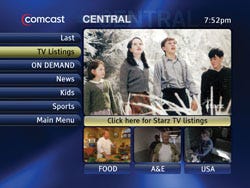Comcast Ramps Up 'Video Rich Navigation'
Rolls out set-top app that helps customers navigate programming using 'picture-in-picture' video thumbnails

Comcast Corp. (Nasdaq: CMCSA, CMCSK) has been quietly rolling out an advanced set-top application that helps customers navigate wide swaths of linear and on-demand programming through the use of "picture-in-picture" video thumbnails and other new program guide features.
Comcast has deployed the application -- marketed to the industry as "Video Rich Navigation" (VRN) but offered to customers under the Comcast Central brand -- to roughly 5.7 million digital set-tops. (Note: Many subscriber homes use more than one digital set-top.)
Comcast has already introduced the app in Chicago, Independence, Mo., and a number of other systems in its Midwest and South regions. The operator is also expected to launch VRN capabilities in its hometown of Philadelphia this spring, and, according to the Comcast Media Center (CMC), is exploring an adapted version of the app for the MSO's Western U.S. region, which includes Denver and San Francisco.
Comcast introduced the concept publicly at the 2005 Cable Show in San Francisco, and followed with its first field tests in the fall of 2005 and initial deployments in 2006. The technology is a product of the CMC and GuideWorks LLC , a joint venture of Comcast and Gemstar-TV Guide International.  The app requires the "A24" version of the GuideWorks iGuide, and presently works only on Motorola Inc. (NYSE: MOT) set-tops, with the widely deployed DCT2000 model as the lowest common denominator. The CMC and its partners are also looking to port VRN to other set-top platforms, pending market demand.
The app requires the "A24" version of the GuideWorks iGuide, and presently works only on Motorola Inc. (NYSE: MOT) set-tops, with the widely deployed DCT2000 model as the lowest common denominator. The CMC and its partners are also looking to port VRN to other set-top platforms, pending market demand.
The application and the technology behind it are designed to help customers navigate an ever-increasing amount of linear and on-demand programming choices; it's considered the next step beyond the traditional grid-based navigation schemes found in most cable interactive program guides (IPGs). It is also a competitive foil to mosaic applications already developed and deployed by DirecTV Group Inc. (NYSE: DTV) and EchoStar Satellite LLC
Comcast generates a range of pre-set "pages" for the Video Rich Navigation system. In addition to the Comcast Central home page, thematic pages include "News," "Sports," and "Kids." Each page offers as many as six full-motion video thumbnails of the featured networks. Customers hear only the audio feed of the selected thumbnail.
In addition to full-motion video of each network, each page also supplies data streams that originate from the Comcast Media Center. The "News" page, for example, feeds headlines and other news elements that are programmed in real-time by the CMC.
The VRN is also designed to support "Poster Pages," which use images and movie poster art to spice up and promote Comcast's high-definition video-on-demand offerings.
Further, the system is made to integrate Comcast's linear and on-demand video services, allowing customers to move directly to a VOD program without requiring them to push additional buttons on their remote and wade through the traditional grid-based navigation system. Comcast, for example, is leveraging VRN technology to support a limited test to highlight the MSO's new FEARNet VOD service and to test the mettle of "virtual networks" that market VOD fare in much the same way traditional linear television is today.
"It's hyperlinking for television," says Mitch Weinraub, the CMC's executive director of products and services.
Although the MSO offers Comcast Central to digital subs at no additional cost, it does require the systems that deploy it to free up some bandwidth.
Depending on how an operator is multiplexing its digital networks, most can fit between 10 to 12 digital networks within one 6MHz channel. The VRN's full thematic slate would then take up the space of about four digital channels, or less than half of a 6MHz slice of spectrum, according to Weinraub. Poster Pages take up much less capacity because they use static images (instead of full-motion video) and do not embed data and audio streams.
Another challenge, particularly for Comcast's markets in the western U.S., will be to ensure that featured channels sync up with the correct regional program feed. For example, a new Kids page must be developed so that the west feed of Nickelodeon is featured in thumbnail form and that the correct feed is maintained if the viewer decides to watch it in full-screen mode.
The CMC and GuideWorks have not yet developed a version that allows customers to customize their own VRN pages, though they are "working on some theories," Weinraub says.
He adds, however, that the CMC and its VRN partners are perfectly capable of creating custom versions for other cable operators. Some MSOs other than Comcast "have expressed interest" in using the technology, Weinraub says, declining to go into further detail about those discussions.
— Jeff Baumgartner, Site Editor, Cable Digital News
About the Author(s)
You May Also Like












